Living things: Classifying big and small
Use this unit hub to inform your medium-term plan and navigate related resources.
We’re monitoring the upcoming 2025 National Curriculum updates and will revise our resources when we know more. Learn more
- Subjects >
- Science >
- Upper key stage 2 >
- Year 6 >
-
Living things: Classifying big and small
Unit outcomes
Pupils who are secure will be able to:
- Define the term ‘organism’ and name the seven life processes of all living things.
- Describe the work of Carl Linnaeus.
- Define the term ‘vertebrate’ and name the vertebrate groups.
- Describe the characteristics of fish, amphibians, reptiles, birds and mammals.
- Compare the characteristics of the vertebrate groups.
- Define the term ‘invertebrate’.
- Describe the characteristics of worms, snails, spiders and insects.
- Compare the characteristics of the invertebrate groups.
- Name the plant groups.
- Describe the characteristics of flowering plants, ferns, mosses and conifers.
- Define the term ‘micro-organism’ and name some examples.
When working scientifically pupils who are secure will be able to:
- Use a classification key to group and identify organisms.
- Make a simple classification key.
Please note that Kapow Primary Science lessons are designed to be 1 hour and 30 minutes long, to reflect the requirements of a core subject.
Suggested prior learning
Living things: Classification and changing habitats
Get startedLessons
Lesson 1: Carl Linnaeus and classification
Knowledge
- To explain how organisms are classified using the Linnaean system.
Lesson 2: Cold-blooded vertebrates
Knowledge
- To classify the cold-blooded vertebrate groups using their common characteristics.
Working scientifically
- To use a classification key to classify frog species.
Lesson 3: Warm-blooded vertebrates
Knowledge
- To classify the warm-blooded vertebrate groups using their common characteristics.
Working scientifically
- To use a classification key to classify vertebrates.
Lesson 4: Invertebrates
Knowledge
- To classify invertebrates using their characteristics.
Working scientifically
- To use a classification key to classify invertebrates.
Lesson 5: Plants
Knowledge
- To describe how the plant kingdom is organised (based on shared characteristics).
Working scientifically
- To produce a working classification key.
Lesson 6: Micro-organisms
Knowledge
- To describe and classify micro-organisms.
Working scientifically
- To use a classification key to classify bacteria.
Key skills
Related content
Unit resources

Knowledge organiser – Science Y6: Living things: Classifying big and small
Aimed at pupils, two pages providing key facts and definitions from the unit ‘Classifying big and small’.

Vocabulary display – Science Y6: Living things: Classifying big and small
A display version of the vocabulary from the unit 'Classifying big and small'.
Cross-curricular opportunities
British values: mutual respect.
Art: clay sculpture.
English: writing.

